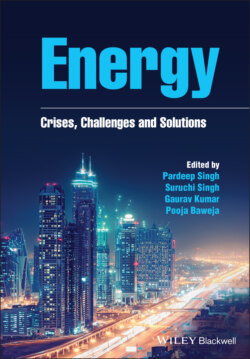Читать книгу Energy - Группа авторов - Страница 18
1.5.2 Process and Causes of Global Warming
ОглавлениеThe earth gets enough space from radiation coming from the sun. To hold Earth’s temperature at an optimal level, greenhouse gases play a crucial role in trapping the solar heat needed to sustain life. This phenomenon is natural, known as the greenhouse effect, and therefore important for sustaining various life forms on Earth. Without the greenhouse effect, Earth’s temperature would be around 33 °C lower than it is today (Morice et al. 2012). Human activities have led to substantial increases in atmospheric GHGs due to deforestation and high fossil‐fuel combustion rates in recent decades. Over the last century, GHG production is the primary cause of global warming. Earth warming ranged from +0.8 to +1.0 °C after 1900, according to published literature (Figure 1.3; den Elzen and Meinshausen 2006). Since 1950, land‐only observations have shown warming trends between +1.1 and +1.3 °C, as land temperatures usually react rapidly in the climate change phase compared to oceans. Various factors affect the Earth’s climate, including solar (warming effect), volcanic eruptions (and their cooling effect) and atmospheric GHG levels (warming effect). Methane‐led carbon dioxide (CO2) has been a significant contributor to global warming since the Industrial Revolution of 1750, with CO2 concentrations rising from 278 parts per million (ppm) in 1960 to nearly double at 401 ppm in 2015 (Levitus et al. 2005). Since 1951, almost 100% of the warming is due to anthropogenic activities. Human activities are now responsible for increasing global temperatures by 1.1 °C, and according to reports, global emissions are already heading towards 1.5 °C or near‐mid‐century targets.
Figure 1.3 Instrumental temperature data 1880–2014.
Source: NASA Goddard Institute for Space Studies (GISS).
Because of an increase in GHG concentrations, water vapour has a significant indirect impact on temperature changes. High global temperatures increase the atmosphere’s ability to absorb water vapour due to GHGs, which increases temperature, as water vapour also contributes to the greenhouse effect. Thus, an increase of 1 °C in global temperature results in an increase in atmospheric water vapour by around 7%. Therefore, it is clear that while CO2 is the primary candidate for anthropogenic climate, water vapour amplifies the effect and is, therefore, a central agent of climate change (Gillett and Matthews 2010). Limiting global warming to below 2 °C worldwide is widely seen as an effective aim to reduce dangerous warming. Still, it is unlikely to be achieved without major reductions in GHG emissions (Canadell 2007). More than 100 countries have agreed on a global warming limit of 2 °C or less as a benchmark for mitigation steps to reduce the risks, impacts and damage caused by climate change (relative to pre‐industrial levels).
